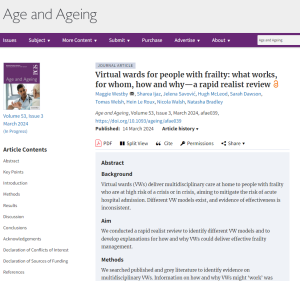Rapid realist review + virtual wards + people with frailty = ?
24 July 2024
In this blog Maggie Westby talks about tackling a rapid realist review for a project on frailty virtual wards. This is an edited version of a blog originally published by the British Geriatrics Society on 24 July 2024.
Shortly after joining NIHR ARC West in September 2021, I was assigned to a rapid realist review project on frailty virtual wards. I’d worked on frailty projects before, thought I could handle virtual wards, but realist review methodology? Well, I’d heard of realist reviews… Happily, I like doing new things, and even better, we brought in an expert in realist review! I offer here a systematic reviewer’s perspective on how this work can really make a difference.
At the outset, we needed to define (frailty) virtual wards (VWs) and agreed a definition from the literature:
- Care is provided to the patient in their own home
- A multidisciplinary team (MDT) makes decisions and plans care remotely from the patient
- The MDT provides oversight of patient care
‘Virtual’, here, means the MDTs plan each patient’s care remotely (it is not intended to signify remote patient monitoring, which was rarely found for frailty VWs). We considered VWs as service delivery under one ‘virtual roof’.
About rapid realist reviews (RRR)
VWs are a complex intervention and there is mixed evidence of their effectiveness. We thought a realist review would give different answers to the effectiveness questions.
Correction! We asked different questions: not whether VWs work, but how and why they work, who they work for, and in what circumstances. And armed with that knowledge, how can we make VWs more effective?
Realist reviews can inform policy – and this is pertinent for VWs. Shortly after starting our review, NHS England published guidance on acute care VWs for people having a frailty crisis, for roll-out across England.
RRRs generate theories through an iterative process. We started by extracting ‘if-then-because’ statements from the evidence, then summarised them under VW component headings. Evidence was from any source, ranging from literature articles to videos and blogs.
Working with three clinicians and eight patient/public contributors, we revised and transformed these statements into 12 ‘context-mechanism-outcome configurations’ (CMOCs) under three main themes:
- Building blocks underpinning VW operation
- VW delivering frailty interventions
- Patient and caregiver experience and empowerment [See the paper, Appendices].
As an example, the following ‘if-then-because’ statement (and others) contributed to CMOC3, ‘Multidisciplinary composition and co-ordination’, under the Building blocks theme:
“If there is a lack of understanding of the wider perspective and aim of the virtual ward, then collaboration and consequent success of the virtual ward is undermined because of role protectionism in the team”.
‘Context’ (backdrop) included frailty management expertise across multiple teams. ‘Mechanism’ included all parties trusting the VW can provide safe and personalised care for patients at home, and having a shared approach to tasks and problem solving. Outcomes included improved patient access to a range of interventions.
CMOCs informing practice
Our first main theme ‘Building blocks’ included common standards agreements, information sharing, an appropriate composition MDT, MDT meetings (‘virtual ward rounds’) and a VW coordinator.
However, identifying building blocks is only part of the story. The realist review informed how to best operationalise them and manage change: motivating professionals (e.g. in a ‘team-of-teams’); achieving buy-in; and building and maintaining relationships amongst professionals and with patients and caregivers.
The other themes addressed how the VW best delivers outcomes for people with frailty, alongside patient/caregiver involvement. This may sound mundane, but in fact the review transported us to a different place, revealing how the VW can accommodate the principles of preventative care and sustainability, plus the wider context of helping people with frailty within the whole health and care system.
Getting to the heart of it
Realist review is an interesting iterative process. As we probed the evidence more and talked with the stakeholders, our understanding grew, and other factors emerged.
The management of people with frailty in the UK seeks to prevent deterioration, offering multicomponent, proactive interventions for people with severe frailty, such as comprehensive geriatric assessment (CGA). These attempt to prevent people living with frailty from reaching a crisis → which may lead to poor outcomes – and it doesn’t take much to tip someone with severe frailty over into a crisis → from which they don’t fully recover → which puts them more at risk of another crisis. A vicious circle that needs to be broken.
The review identified two main types of VW for people with frailty in the UK, distinguished by the type of patients and the type of care: (a) proactive care for frail people close to a crisis, and (b) acute reactive care for frail people with crises, within a short time frame (1-21 days). Both models aim to prevent hospital admission, either by preventing the crisis itself, or by treating the crisis out of hospital.
The review suggests some issues with acute VWs: they admit patients already in crisis (i.e. not preventative). VWs that are not 24/7 rely on the family/caregivers being able to cope with crises, and there may not be time in the VW to start and establish proactive care to prevent future crises – this requires continuation of care after VW discharge (which may not be happening).
Our research offers some solutions
- Having a single VW for both patients in crisis and those close to a crisis (possibly in red and amber wards), ideally moving towards a proactive approach to prevent the crisis.
- Working together (whole system approach) to identify patients at high risk of a crisis – those patients ‘wobbling’ on the edge of a crisis.
- Ensuring that proactive care is started/established either within the VW or after discharge from it – to the point that the patient’s frailty becomes stabilised (whole system approach).
The challenge is huge with an ageing population and insufficient hospital and VW beds. VW sustainability itself may be achieved by focussing on proactive care to prevent crises and taking a whole system approach.
About the author
Maggie Westby, is a systematic reviewer and methodologist with over 20 years’ experience, including 10 years as a NICE guideline developer and clinical effectiveness lead. She is currently working for the NIHR ARC West. Her recent paper Virtual wards for people with frailty: what works, for whom, how and why—a rapid realist review was published in Age and Ageing earlier this year.
In addition to this Maggie and the Bristol team have published a policy briefing paper: Making virtual wards for frailty work better: guide for commissioners, a news summary: Rapid realist review reveals how to achieve effective virtual wards for people with frailty, and a presentation to NHS England SW virtual wards forum.
Paper

